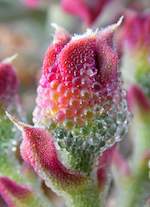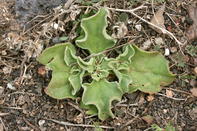
A simple plant with a complicated name; the crystalline ice plant (Mesembryanthemum crystallinum) has many colloquial names such as Rosa De Jericho or brakslaai, noeta and olifantslaai in Afrikaans.
The crystalline ice plant is a low-growing creeping succulent with fleshy flat green to red leaves covered with minute blister-like ‘bubbles’. The leaves are edible.
The plant has pink flower buds which produce delicate multi-petalled white flowers that bloom all year round. The plant is extremely salt tolerant and can grow in soil with a salt content similar to seawater.
This extremely drought and stress-resistant plant is native to Africa, but was introduced by ships to California in the 1500’s and has since been declared an invasive plant in the USA.
The Uses of Ice Plants
A group of Japanese researchers of the Saga University took 20 years to develop a commercial crystalline ice plant called Barafu that they sourced from a desert area in South Africa.
‘Barafu’ means crystal or ice in Kiswahili, a name that reflects the appearance of its leaves. Barafu is a speciality item exported from Japan to outlets in Europe and America, selling from $80 for a small packet.
The leaves and stems can be eaten raw (salads) or cooked and have an acidic and salty taste. It can be steamed, stir-fried, blanched or pickled like cucumbers and will complement seafood dishes.
When cooked it is served as a spinach substitute. Seeds are eaten in times of severe food scarcity.
Ice Plant as Medicine

Medicinally the ice plant is used in the treatment of respiratory and bladder and vaginal inflammations and in Argentina it is used to treat venereal disease. Fresh juice of the crushed leaves may treat water retention and painful urination and is also used to ease and soothe inflammation in the lungs.
The Japanese study, referred to earlier, has also found that the ice plant has high antioxidant activity and accumulates proline, a non-essential amino acid involved in the production of collagen (a protein that is a building block of ligaments, tendons and the skin).
Proline can also assist wound healing and is also a building block of a compound which maintains and heals cartilage and strengthen joints, tendons and muscles.
The leaves are used in the treatment of dysentery (infection of the intestines) and diseases of the liver and kidney. Sailors used the leaves to treat scurvy on long sea voyages.
The crushed leaves are used as a soap substitute and the juice, as well as an extract of the plant, are used as skin conditioning ingredients in commercial cosmetic products.
Growing Ice Plant
Ice plants can be grown from seed. The species has both male and female organs (hermaphrodite) and is pollinated by insects. Mice and rabbits spread the seeds. It prefers well-drained soil and can grow in nutritionally poor and saline soils. It cannot grow in the shade and is sensitive to frost.
The ice plant accumulates nitrates (salts) and later releases them into the soil. This can be detrimental for follow-up species to establish themselves in this saline soil.
Studies have shown that the ice plant may absorb pesticides, cadmium and other heavy metals. So, care must be taken when growing the ice plant to ensure it is safe for human consumption.
Please note: Information is for educational and informational purposes only and may not be construed as medical advice. The information is not intended to replace medical advice or treatment offered by healthcare professionals.
By Marinda Louw